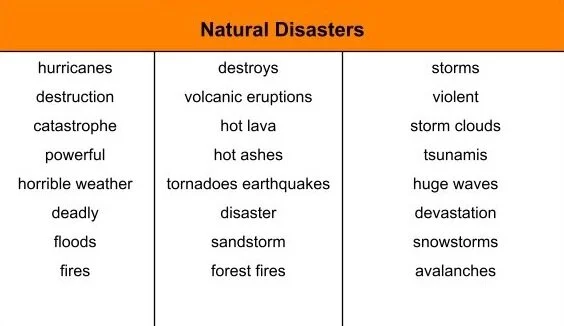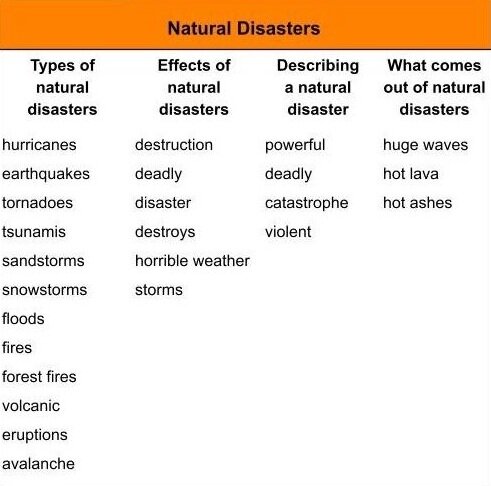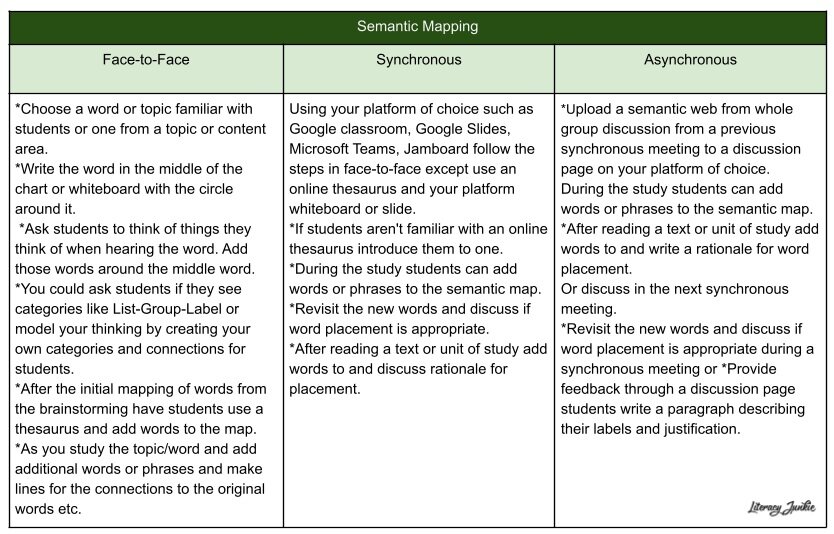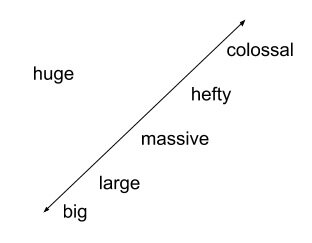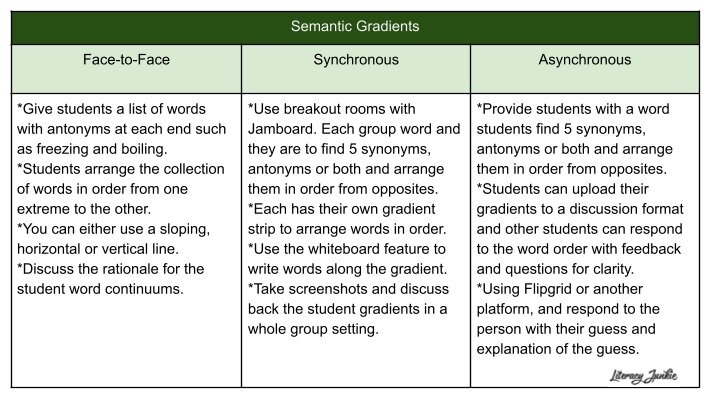“Good vocabulary instruction helps children gain ownership of words, instead of just learning them well enough to pass a test.
Good vocabulary instruction provides multiple exposures through rich and varied activities to gain meaningful information about the word.”
Learning is immensely dependent on vocabulary knowledge.
Education has over 100 years of studies showing students having difficulties with word knowledge and word relationships beginning with Thorndike (1917) and Davis (1944). In 1950, Kottmyer wrote about teachers having “vexing problems” with vocabulary instruction. It is also well known in the research and practitioner world that a wide vocabulary is a strong predictor of reading comprehension. It’s somewhat obvious too, when we don’t understand the meanings of words it’s gibberish and readers are barking at the print. Yet, there are still obstacles for allowing adequate instructional time devoted to vocabulary instruction. While wide reading is a tremendous way to learn new words (Anderson & Nagy, 1992). It isn’t enough. We have children who enter kindergarten with limited vocabulary knowledge lagging behind their peers and English language learners with limited vocabularies. These gaps grow over time without strong and robust word work instruction.
Highly engaging and effective vocabulary instruction is not to assign 15-20 vocabulary words then complete skill-building exercises like drawing a line from the word to the definition, fill-in-the-blank, or write three sentences with each word, then test Friday. The research just doesn’t support this type of instruction for long term and in-depth word learning.
So how can you support vocabulary development and reading comprehension? Think of words learned in patterns, not in isolation (generally). Patterns such as:
Morphological patterns (word families) - prefixes, roots and suffixes
Syntactic patterns (grammatical construct) - how words fit into a sentence: adjective, nouns, verbs, etc.
Semantic patterns - relationships among words & multiple meanings
When you teach word-learning strategies in the above-mentioned patterns it helps to facilitate inferencing, resolve misconceptions and ambiguities, and use contextual information. In today’s blog, I’ll briefly discuss developing word consciousness, and talk about five instructional activities for semantic patterns that can be used face-to-face, synchronous, or asynchronous instruction.
Let’s talk about cultivating a love of words in your students...
Word Consciousness is helping students to develop an appreciation and curiosity for words and how to use them. It's hopefully falling in love with words, but more importantly, it's understanding their power. According to Anderson and Nagy (1992), word consciousness is an awareness and interest in words, their meanings, and how they work. And it's our job to help cultivate a rich environment to allow for many different opportunities for conversations around words and phrases. When students have an appreciation of words, they understand how to use them to express themselves with specificity and emotion. Developing word consciousness is one component of an effective vocabulary program that should begin in preschool. Here are four things you can do to cultivate word consciousness in the classroom?
1) Provide multiple opportunities across different contexts to notice and discuss words, their meanings and how authors use them. When you allow time for this, it means it has value and it's your investment in rich and meaningful vocabulary instruction. Students begin to see that language; more specifically, words have value and power.
2) Create charts of interesting words and phrases from good narrative and informative texts. But don't just leave them up on the wall. Discuss them daily. Have discussions on why they added these words.
3) Encourage your students to be word detectives. Invite students to add cool words they find to the charts. These could be words from their readings, conversation at home, overheard conversations, or TV.
4) Foster Word Play and create curiosity by investigating words and phrases. Explore synonyms, homophones, idioms, and puns.
As Scott and Nagy stated in the quote at the top, learning new words is an investment in our students. Teaching word consciousness should be an investment at all schools with all teachers. When students have an awareness, interest and enjoyment for word learning they will be able to navigate the written language through the power of words.
Activities to Cultivate Word Consciousness
4 Images 1 Word
4 Images 1 Word is a word association game to develop word consciousness. This is a fun game for students to become aware of words and how they are used.
In groups, students identify one word or phrase based on four photos/pictures. You can provide clues as well. The groups also have to provide evidence or reasons for their word choice, which I think is the best part. Explain why and defend your answer. The groups state how they arrived at the one word. If groups come up with more than one, write the words on a chart paper or whiteboard and give sticky notes for all students to choose the best word. See which word has the most votes and discuss.
Educational neuroscience and vocabulary research support the idea of using images to help with comprehension. I know, I’m stating the obvious. The images and the student discussions help with word flexibility, how words are interrelated, and the specificity of vocabulary. Not just the definition, but when to use words.
Understanding that peeved, vexed, irritated and irate are all similar to mad but their meanings have subtle differences, shades of meaning, that can make a huge difference in ones speaking, writing and reading.
When students start using a thesaurus or learn a new word, they over generalize and that’s okay. Start having more guided conversations and spaced practice/review around those target words to create memories for long term learning.
I do recognize that making these takes time. I recommend collaborating with grade level teams and using Unsplash, Pixabay or Pexels for free images.
Guess My Word
Another fun activity to foster word consciousness is an activity called Guess My Word. It's a collaborative conversation in a game format. This is a fun experience for students practice work learning. Guess My Word should be played after the students have already had several interactions with the words. It provides a structured open ended experience for students to practice using specific language. The speaker monitors, refines and controls language for another person. While the listener shows interest and asks for clarity when needed. Guess My Word provides time for language and thinking.
**This game was inspired by an activity called Password, in the 1st edition of Words Their Way by Bear, Invernizzi, Templeton, and Johnston (1996). This game could be played in partners or small groups of 4-5.
Linking Activities for Semantic Patterns
Semantics is the study of meaning and semantic patterns (polysemy) are words with similar and related meanings. We can think of this as the flexibility within words or linking strategies. The linking strategies I describe below all deal with semantic patterns and creating categories to help form connections and relationships so students will use and understand words in varied contexts. When words, ideas, or concepts are mentally well organized, students are better able to retrieve information (Johnson & Pearson, 1984). Studying word flexibility also develops and improves critical thinking, reasoning ability and memory (Shanker & Ekwall, 2003).
Because these activities work very well in a face-to-face environment, with some tweaks, they will work well in a synchronous or asynchronous classroom.
List-Group-Label
For students to develop word knowledge and have a strong vocabulary, vocabulary instruction must involve ongoing purposeful interactions with words to build semantic networks. One instructional strategy I love for diverse learners at all grade levels is List-Group-Label (LGL) (Taba, 1967; Tierney & Readence, 2005) because students do a lot of talking and thinking. It’s also flexible for all grades and learners.
LGL allows students to see how words are related and grouped. Before studying a topic or reading a book, have your students brainstorm words related to the topic. Write all words students come up with on a whiteboard or chart paper. Accept all words at this time. As a whole group, guide students in noticing how the terms are related and create a meaning making category with a label and not a structural label such as two three syllable words. Students explain their reasoning for the category and label.
LGL helps students activate prior knowledge and build conceptual knowledge when students share their thinking for the categories and labels. There’s that talking and thinking component which is needed for new learning.
If this is a new strategy for your students, model which words are similar and do a think-aloud of how you categorize and label words. Modeling these steps will be especially important if your students are having difficulty with categorization.
After reading a book or studying a topic, students identify new words for the chart/graphic organizer. Again students should explain their reasoning for placing word(s) in the categories. Sometimes new categories will emerge after reading or studying a topic. It's the conversations students have around these words that help with new learning. I’ve seen dynamic conversations with this instructional strategy. If you’ve incorporated, “I agree/disagree with ___ because of ….”, this is a great reminder to use those sentence frames for these discussions around words.
Whole Group Brainstorming Chart
Small Group Categories
Semantic Maps
Another fun and challenging favorite is semantic maps, also known as word webs, a visual instructional strategy to expand conceptual knowledge by building relationships and ideas among words. It actively engages students before reading by organizing and categorizing new terms and concepts, so they have a visual of how words are related, similar to List-Group-Label. Word Webs also allows students to extend and clarify their knowledge of these new words by building relationships or new mental highways to connect the latest information (Heimlich & Pittleman, 1986). Remember, semantic maps is live graphic organizer that should be continually revised during a unit of study to reflect the learning and thinking of your students.
Words webs are great for:
Word families (e.g., look, looks, looked, looking, looker, lookout, overlook, look-alikes, etc.)
Parts of speech and their uses in a sentence
Synonyms/antonyms
Etymology including root words and affixes
Nuances or shades of meaning (e.g., calm, unbothered, nonchalant, serene, composed)
Semantic Gradients AKA Shades of Meaning
What is it? A list of related words that have similar meanings placed on a continuum moving from one word to it’s opposite for example, freezing - cold - cool - warm - hot- boiling. It could also be a family of words with similar meanings, such as friendly - sociable - outgoing - gregarious. Semantic gradients or continuums also help students develop a greater understanding of the nuances between words, or the shades of meaning. It’s these nuances that help us communicate better and the power of why word specificity is important in speaking and writing. Again, it links those connections between words and their relationships. I always think it should be called a semantic continuum instead of gradient, it’s more fitting to me.
Formative Assessment
Monitor groups with a clipboard to clarify misconceptions, notice and write down good examples to share. The clues the student provides will inform you of one level of their knowledge of the word. I also found this a good time to listen to their oral language skills and take notes of supports in grammar and sentence usage.
Remember, general principles of effective vocabulary instruction hold true for all students. Use oral language channels, and leverage good texts to facilitate discussions and interactions with words. Help students develop word appreciation and word consciousness by providing rich and varied language experiences. Students need multiple opportunities to practice using new vocabulary in intentional and meaningful experiences through reading, writing, listening and speaking. For example discussions and different media presentations with multiple exposures to words. These rich and varied experiences help students understand that words are flexible, related and are used in other contexts.
**Two really cool online tools for educators are the Visual Thesaurus and WordNet, a large English lexical database.
References
Anderson, R.C. & Nagy, W.E. (1993). The Vocabulary Conundrum. American Educator: The Professional Journal of the American Federation of Teachers.
Bear, D. R., Invernizzi, M., Templeton, S., & Johnston, F. (1996). Words Their Way: Word Study for Phonics, Vocabulary, and Spelling Instruction (1st ed). Merrill Publishing Company.
Heimlich, J.E., & Pittelman, S.D. (1986). Semantic mapping: Classroom applications. International Reading Association.
Johnson, D.D., & Pearson, P.D. (1984). Teaching reading vocabulary. Rinehart Winston.
Graves, M. F. (2006). The vocabulary book: learning and instruction (1st. ed.). Teachers College Press.
Readence, J. E., & Searfoss, L.W. (1986). Teaching strategies for vocabulary development. In E. K. Dishner, T. W. Bean, J. E. Readence, & D. W. Moore (Eds.), Reading in the content areas: Improving classroom instruction (2nd ed., pp. 183-188). Kendall/ Hunt.
Shanker, J.L., & Ekwall, E.E. (2003). Locating and correcting reading difficulties. (8th ed.). Merrill- Prentice Hall.
Follow along on Literacy Junkie’s Instagram for Word Work Wednesday, where a few of these ideas have been posted.
If you like this, please share it with a friend to two.




